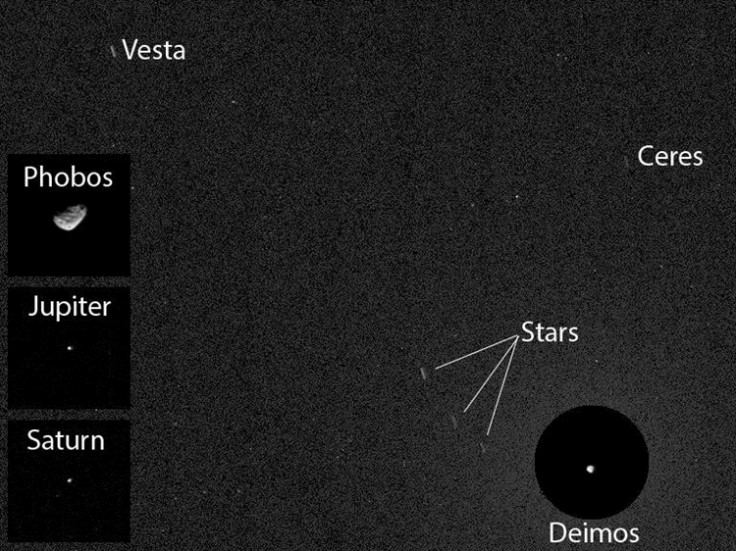Nasa: Curiosity Mars Rover Captures First Image of Giant Asteroids from Red Planet

Nasa's Curiosity Mars rover has captured the first ever image of asteroids from the surface of the Red Planet.
The rover, which was launched from Cape Canaveral in November 2011, took an image which contained both Ceres, a dwarf planet which is the largest object in the asteroid belt, and Vesta, one of the largest asteroids in the Solar System.
The objects appear as short, faint streaks in a 12-second exposure taken by the Mars Science Laboratory Mast Camera, according to Nasa's Jet Propulsion Laboratory.
"This imaging was part of an experiment checking the opacity of the atmosphere at night in Curiosity's location on Mars, where water-ice clouds and hazes develop during this season," Mark Lemmon, a camera team member at Texas A&M University, told the Space Exploration Network.

He added: "The two Martian moons were the main targets that night, but we chose a time when one of the moons was near Ceres and Vesta in the sky."
Curiosity is a car-sized robotic rover exploring the Gale Crater on Mars, as part of Nasa's Mars Science Laboratory mission.
The rover travelled 350,000,000 miles before touching down on Aeolis Palus, where its goals include investigating the Martian climate and geology, the role of water, microbial life and planetary hability in preparation for human exploration.
The rover's image captures the two asteroids in the main belt between the orbits of Mars and Jupiter. Researchers said the camera was taking photos of the Mars moon Phobos and Deimos, but the camera was triggered at a specific time when Deimos would be closely aligned in the sky with the Ceres and Vesta.
Nasa has a spacecraft, Dawn, which is currently on a mission to study both asteroids. After spending the majority of 2011 and 2012 in orbit about Vesta, it is currently on its way to Ceres, where it is expected to go into orbit in 2015.
Ceres is a ball of rock and ice, measuring 950km in diameter, which contains a third of the mass of the asteroid belt. It was first discovered in 1801 by Giuseppe Piazzi in Palermo and it is one of five dwarf planets known so far, along with Pluto, Eris, Haumea and Makemake. It is the only one orbiting in the inner solar system.
Discovered by Heinrich Wilhelm Olbers in 1807, Vesta measures around 326 miles across. As reported in the Tech Times, both objects are close enough to Mars to be seen with the naked eye, but Ceres - even at its brightest - is generally too dim to be seen from the surface of Earth.
The image comes as Curiosity is about to embark on a dig into a rock formation dubbed Windjana. It is part of an layer of material exposed by wind erosion and is the first mineral Curiosity has investigated for drilling that is not composed of mudstone.
"We want to learn more about the wet process that turned sand deposits into sandstone here," said John Grotzinger, a Curiosity Project scientist at the California Institute of Technology.
"What was the composition of the fluids that bound the grains together? That aqueous chemistry is part of the habitability story we're investigating."
© Copyright IBTimes 2025. All rights reserved.






















